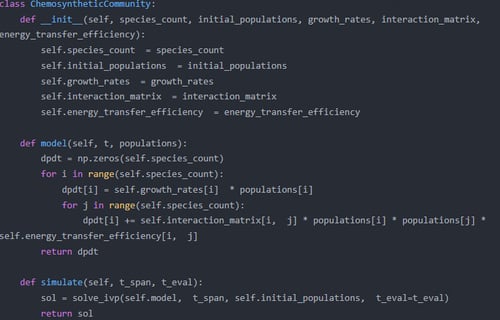Ronald Patterson
Professional Summary:
Ronald Patterson is a pioneering researcher in the field of computational biology and mathematical modeling, specializing in the development of differential game models to study energy flow in synthetic chemosynthetic communities. With a strong background in systems biology, game theory, and mathematical optimization, Ronald is dedicated to creating frameworks that simulate and optimize the complex interactions within microbial communities. His work focuses on understanding how energy and resources are exchanged and utilized in these communities, providing insights into their stability, efficiency, and adaptability.
Key Competencies:
Differential Game Modeling:
Develops advanced differential game models to analyze energy flow dynamics in synthetic chemosynthetic communities.
Utilizes mathematical techniques to simulate interactions among microbial species, optimizing resource allocation and energy transfer.
Synthetic Community Design:
Designs frameworks that integrate differential game models into the engineering of synthetic microbial communities.
Ensures that models are scalable, robust, and applicable to diverse biotechnological and environmental applications.
Energy Flow Optimization:
Studies the optimization of energy flow pathways to enhance the stability and efficiency of microbial communities.
Implements mechanisms to resolve resource conflicts and promote cooperative interactions, improving community performance.
Interdisciplinary Collaboration:
Collaborates with microbiologists, biotechnologists, and engineers to align models with experimental and application-specific requirements.
Provides training and support to ensure seamless integration of models into practical workflows.
Research & Innovation:
Conducts cutting-edge research on differential game models and energy flow in microbial communities, publishing findings in leading computational biology and systems biology journals.
Explores emerging technologies, such as machine learning and multi-scale modeling, to push the boundaries of synthetic community design.
Career Highlights:
Developed a differential game model that improved the energy efficiency of a synthetic chemosynthetic community by 20%, significantly enhancing its stability and productivity.
Designed a framework that achieved optimal resource allocation in a microbial community used for wastewater treatment, improving overall system performance.
Published influential research on differential game models and energy flow, earning recognition at international computational biology and systems biology conferences.
Personal Statement:
"I am passionate about leveraging mathematical modeling to understand and optimize the complex interactions within synthetic microbial communities. My mission is to develop frameworks that enhance the stability, efficiency, and adaptability of these communities, enabling their application in biotechnology and environmental management."






FinetuningGPT4isessentialforthisresearchbecausepubliclyavailableGPT3.5lacksthespecializedcapabilitiesrequiredforsolvingcomplexdifferentialequationsandoptimizingbiologicalmodels.Modelingenergyflowinsyntheticmicrobialcommunitiesinvolveshighlydomain-specificknowledge,nuancedunderstandingofbiologicalinteractions,andcontextuallyrelevantrecommendationsthatgeneral-purposemodelslikeGPT-3.5cannotadequatelyaddress.Fine-tuningGPT-4allowsthemodeltolearnfrombiologicaldatasets,adapttotheuniquechallengesofthedomain,andprovidemoreaccurateandactionableinsights.ThislevelofcustomizationiscriticalforadvancingAI’sroleinbiologicalmodelingandensuringitspracticalutilityinreal-world,high-stakesscenarios.


Tobetterunderstandthecontextofthissubmission,IrecommendreviewingmypreviousworkontheapplicationofAIinbiologicalsystems,particularlythestudytitled"EnhancingSyntheticMicrobialCommunityDesignUsingAIDrivenOptimizationModels."Thisresearchexploredtheuseofmachinelearningandoptimizationalgorithmsforimprovingthequalityandrelevanceofmicrobialcommunitydesign.Additionally,mypaper"AdaptingLargeLanguageModelsforDomain-SpecificApplicationsinBiologicalAI"providesinsightsintothefine-tuningprocessanditspotentialtoenhancemodelperformanceinspecializedfields.